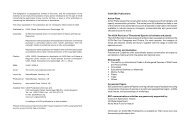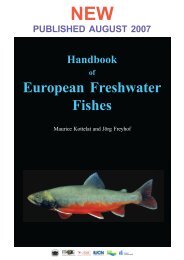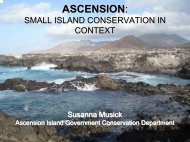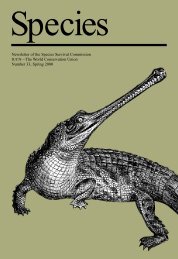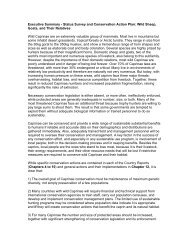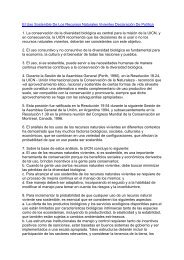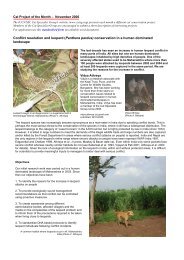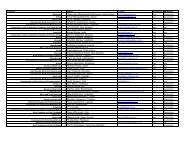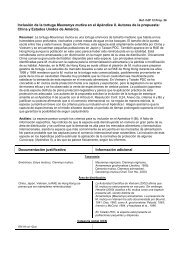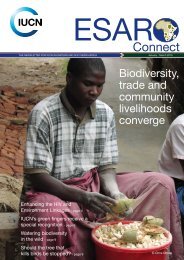Ruling of the IUCN Red List Standards and Petitions Working Group ...
Ruling of the IUCN Red List Standards and Petitions Working Group ...
Ruling of the IUCN Red List Standards and Petitions Working Group ...
Create successful ePaper yourself
Turn your PDF publications into a flip-book with our unique Google optimized e-Paper software.
SPWG takes <strong>the</strong> view that this appeal should have been resolved through earlier actions by<br />
<strong>the</strong> RLA to work with experts on <strong>the</strong> species <strong>and</strong> <strong>the</strong> criteria to agree on a listing. The<br />
involvement <strong>of</strong> SPWG at this stage, before any detailed discussions have taken place, has<br />
not been helpful in resolving <strong>the</strong> matter.<br />
The rest <strong>of</strong> this document is a brief discussion <strong>of</strong> some <strong>of</strong> <strong>the</strong> technical issues that need to<br />
be addressed in <strong>the</strong> course <strong>of</strong> providing a listing for this species.<br />
1. <strong>Red</strong>uction vs. Harvest<br />
The listing <strong>of</strong> <strong>the</strong> taxon on <strong>the</strong> 2006 <strong>IUCN</strong> <strong>Red</strong> <strong>List</strong> provided <strong>the</strong> following justification<br />
(ARW 1998).<br />
An appeal against <strong>the</strong> listing <strong>of</strong> this species was submitted to <strong>the</strong> World<br />
Conservation Monitoring Centre by Dr. David Hammond in 1999. Dr.<br />
Hammond's submission provided corrections to <strong>the</strong> distribution <strong>of</strong> <strong>the</strong> species<br />
<strong>and</strong> some excellent additional documentation. The matter was referred to<br />
colleagues at TROPENBOS for comment as <strong>the</strong>y have a programme in Guyana<br />
looking at this <strong>and</strong> o<strong>the</strong>r species. The conclusion after considering <strong>the</strong> case,<br />
which was also backed up by data from Dr. Hammond, was that <strong>the</strong> species<br />
merits a Vulnerable status as between 15.1 <strong>and</strong> 28.6% <strong>of</strong> <strong>the</strong> original<br />
population has been harvested to date. Harvesting as a commercial timber<br />
began in <strong>the</strong> late 1700s, but most <strong>of</strong> <strong>the</strong> harvesting has only taken place since<br />
<strong>the</strong> introduction <strong>of</strong> chainsaws, etc. in 1967. It is <strong>the</strong>refore reasonable to infer a<br />
20% decline over <strong>the</strong> past three generations.<br />
Thus, 20% reduction was inferred from an estimate that between 15.1 <strong>and</strong> 28.6% <strong>of</strong> <strong>the</strong><br />
original population has been harvested until 1999. More recent calculations by D.<br />
Hammond (pers. comm.) suggest that about 38% <strong>of</strong> <strong>the</strong> original volume <strong>of</strong> harvestable trees<br />
has been harvested until <strong>the</strong> end <strong>of</strong> 2004. Due to uncertainty in <strong>the</strong> size <strong>of</strong> an average<br />
harvested tree, <strong>the</strong> proportion <strong>of</strong> <strong>the</strong> original tree population that is harvested has a large<br />
range (20% to 69%).<br />
However, <strong>the</strong> proportion <strong>of</strong> original population harvested does not lead to a direct estimate<br />
<strong>of</strong> population reduction. Depending on recruitment, this proportion <strong>of</strong> original population<br />
harvested during a 150-year period may lead to a population reduction during that period <strong>of</strong><br />
less than 20% (leading to an LC listing), more than 30% (leading to a VU listing), or even<br />
more.<br />
Population reduction in this case can be calculated in several ways. Some <strong>of</strong> <strong>the</strong>se<br />
approaches are discussed below.<br />
2. Calculating Past <strong>Red</strong>uction<br />
The most straightforward way <strong>of</strong> calculating past reduction would be to estimate past <strong>and</strong><br />
current population sizes. The informal petition <strong>of</strong> 1999 mentioned above included an<br />
estimate <strong>of</strong> past population size <strong>and</strong> an estimate <strong>of</strong> <strong>the</strong> cumulative amount <strong>of</strong> harvest since<br />
<strong>the</strong> beginning <strong>of</strong> <strong>the</strong> commercial harvest <strong>of</strong> this species in <strong>the</strong> mid 19 th century. If this<br />
calculation can be confirmed, it could be used in an assessment, which would also require<br />
an estimate <strong>of</strong> current population size. Although such an estimate is not currently available,<br />
it should be much easier to obtain an estimate <strong>of</strong> current population size than an estimate <strong>of</strong><br />
<strong>the</strong> population size over 150 years ago.<br />
The only region for which population reduction (ra<strong>the</strong>r than just harvest) is calculated is <strong>the</strong><br />
Bartica Triangle (Steege et al. 2002), where <strong>the</strong> density <strong>of</strong> Chlorocardium trees declined by<br />
Page 2



